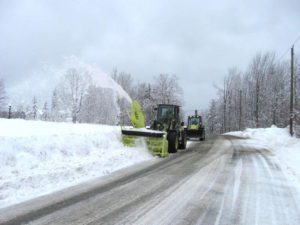Who is a member?
Our members are the local governments of Massachusetts and their elected and appointed leadership.

Snow plow drivers must guard against fatigue and other dangers during the plowing season.
Winter ushers in additional safety concerns for municipal employees such as slippery roads and exposure to cold. But according to David Bastien, MIIA’s defensive driving instructor, distracted driving remains the primary cause of accidents in Massachusetts cities and towns.
Activities such as eating, texting, talking on the phone or changing music selections reduce a driver’s perception and reaction time. Simply put, you need time to react to what’s coming.
“Human error combined with bad weather can be quite a catalyst,” Bastien said. “Many people have a very casual, hands-free attitude about driving,” especially in the winter, Bastien noted, when drivers should be more alert than ever.
We’ve all seen the snow-covered SUV or truck on the road with one little circle cleared on the driver’s side windshield.
“What’s your visibility? Can you see the road?” Bastien asked. “Drivers are required by law to clean their windshields and windows from frost. You shouldn’t be driving if you don’t have visibility.”
Loss of control on a slippery road can often be prevented by not speeding up too quickly.
“Slow acceleration in snowy conditions is the key to avoiding fish-tailing,” Bastien said.
Other common seasonal hazards include solar glare and black ice. Recognizing these potential hazards is key to defensive driving.
“If there are brake lights in front of you, slow down,” Bastien said. “You need time to react. I tell the snowplow drivers when I’m training them, ‘You know other drivers are going to speed up to get around you, so expect it.’”
Being groggy behind the wheel is dangerous for everyone on the road. Adults need seven to nine hours of sleep each night in order to regenerate, according to the National Sleep Foundation.
“I tell the DPW drivers who might be on a 15-hour shift during a snowstorm, ‘Pull over! Take a rest and re-energize on the side of the road,’” Bastien said. “How can you maintain the roads if your plow is out of service from a fatigue-related accident?”
Winter weather can expose outdoor workers to ailments such as frostbite, hypothermia and cold stress, all of which can be fatal, according to the Occupational Safety and Health Administration. It’s important to pay attention to the temperature and follow these guidelines in order to work safely in extreme temperatures:
• Dress properly. Wear at least three layers of loose-fitting clothing, insulated gloves and boots — and cover your head.
• Stay dry and pack extra clothes; moisture can increase heat loss from the body.
• Monitor your physical condition and that of your coworkers.
• Know the symptoms of cold stress: reddening skin, tingling, pain, swelling, leg cramps, numbness and blisters.
• Take frequent breaks in warm, dry areas.
• Drink warm liquids.
In addition to road surfaces, employers should clear snow and ice from sidewalks and distribute salt on walking surfaces as soon as possible after a storm.
According to OSHA’s winter safety tips fact sheet, if walking on snow or ice is unavoidable, workers should be trained to wear footwear that has good traction and insulation, and take short steps and walk at a slower pace in order to be able to react quickly to changes in traction.
Written by Kathy Geller, freelance writer